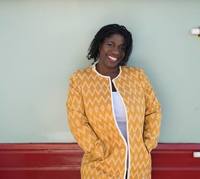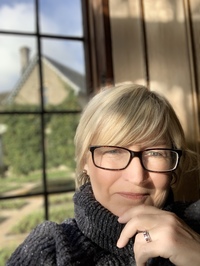Genre: Contemporary Fiction
Publisher: Simon and Schuster 2021
Source: Tywyn Public Library
First Sentences: Flappy Scott-Booth, the self-styled queen of the small but not insignificant Devon town of Badley Compton, sat on the high-backed Russian imperial chair she'd bought at auction from Christie's and scrutinized the fresh face of the young woman sitting formally and a little nervously, on the other side of the walnut desk.
Review Quote: 'Packed with wickedly funny insights and throwaway lines and written with an extra-large helping of heart, this is the perfect escape for anyone in need of of a book hug!' Lancashire Post
My Opinion: Humorous fiction is a new direction for Santa Montefiore to take her writing. She has written this novel, especially for the character of Flappy Scott-Booth who originally appeared in 'The Temptation of Gracie'. She had so many emails about her at that time. This influenced her decision to expand her role and feature her as protagonist in a series of novels, of which 'Flappy Entertains' is the first.
For me personally it was an amusing, very light hearted and a quick read. A little far fetched and incredibly lightweight compared to her other novels which have much more substance to them. Disappointing and I think only really dedicated fans of her writing will enjoy this series. Sorry not for me, but I am sure I will continue to enjoy her writing. Just not this particular series.
My reviews of other novels by Santa Montefiore: Secrets of the Lighthouse
The Swallow and the Hummingbird The Summer House The House by the Sea
The French Gardener The Beekeeper's Daughter Here and Now
Précis Courtesy of Goodreads:
Flappy Scott-Booth is the self-appointed queen bee of Badley Compton, a picturesque Devon village. While her husband Kenneth spends his days on the golf course, she is busy overseeing her beautiful house and gardens, and organising unforgettable events, surrounded by friends who hang on to her every word.
Her life is a reflection of herself – impossibly perfect.
Until the day that Hedda Harvey-Smith and her husband Charles move into the village. Into an even grander home than hers. Taking the front seat on the social scene, quite literally.
That simply will not do.
Flappy is determined to show Hedda how things are done here in Badley Compton. But then she looks into Charles’s beautiful green eyes. And suddenly, her focus is elsewhere. She is only human, after all…
Author Profile:
Born in England in February 1970 Santa Montefiore grew up on a farm in Hampshire and was educated at Sherborne School for Girls. She read Spanish and Italian at Exeter University and spent much of the 90s in Buenos Aires, where her mother grew up. She converted to Judaism in 1998 and married historian Simon Sebag Montefiore in the Liberal Jewish Synagogue in London. They live with their two children, Lily and Sasha in London.
The following Biography, in her own words is Courtesy of Santa Montefiore Official Website
Since I was a child I always wanted to be a writer. I dabbled in books throughout my youth, from children’s stories to rather naïve love stories as I got older. From the age of 12 I went to Sherborne School for Girls, which was a boarding school. There I excelled in English, which was lucky because I certainly didn’t excel at much else except for sport and music! I wrote stories for my friends, imagining romances between them and the spotty youths they fancied at Sherborne Boys’ School. I transformed them into Rhett Butlers and set them in humid, mosquito infested jungles, which I considered extremely romantic, having never been in one. This seemed to satisfy them and I was in great demand to write more. Fancying myself a bit of a novelist, especially after a writer friend of my mother’s read one and suggested I send it to a publisher, I attempted a novel. With little experience of love and life it wasn’t a surprise when it was rejected. The trouble was I hadn’t yet found a good story. That came later, when I went to live in Argentina.
I was 19. My Anglo Argentine mother arranged for me to work on an estancia on the Argentine Pampa for a year, teaching English to three young children. This turned out to be one of the best things my parents ever did for me for I fell in love. Not with a polo playing Argentine, although I did have an innocent flirtation, but with the country. I lost my heart to those flat, humid plains and still, after 5 books, I have not managed to retrieve it. You see, Argentina is intoxicating. The countryside is rich with the scents of eucalyptus and gardenia, the sound of horses snorting in the fields or thundering up the polo pitch, birdsong and crickets resounding across the park. The houses, colonial in style, are painted white and yellow with dark green shutters to keep out the stifling summer heat, and surrounded by brightly coloured flowers and red tiled terraces upon which one can sit and stare out for miles over that vast plain. It is difficult to see where the sky begins and the earth ends, the horizon is simply mist. One feels very small. I spent a lot of time on a pony, riding to the neighbouring estancia for tea with friends, cutting across the plain, through the long grasses alive with prairie hares. Little by little I began to feel that I was a part of the place.
Buenos Aires is a city heavy with the sense of nostalgia. When the immigrants arrived from all over Europe, lured by the promise of rich pickings and new lives at the end of the 19th century, they recreated in the architecture echoes of their own homelands to stave off the inevitable homesickness. Thus, the Colón theatre is reminiscent of the Scala in Milan, the plazas of Madrid, the tall roofed buildings of Paris, the palm tree lined avenues of the South of France. Cafés spill out onto pavements where the waiters are all over sixty and one can sit in the shade and listen to the melancholy notes of the tango wafting on the breeze, thick with the scent of jasmine and diesel.
I left Argentina after a year, having belonged. The following year I returned during my university holiday to find, to my dismay, that I no longer fitted in. The young people I had hung out with had either gone to the US to study or had boyfriends or girlfriends and didn’t go down to the farm so much anymore, preferring to be in the city. I didn’t have a job, I was a tourist. I had nothing to get me up in the morning and the friends I had made in shops and cafés in the streets where I lived had moved on. I felt a sharp sense of alienation as if I was watching it all through a pane of glass where the year before I had been on the other side. It was a difficult time and I cried all the way home on the plane. However, I didn’t realise it then but I had my story.
We have all had moments that we would give anything to live again. However much we try, time cannot be reversed. It changes us and those we were once close to. My first novel, published in 2001, 12 years after my first trip to Argentina, was a wander down memory lane for me and hence very cathartic. I was able to channel all my feelings of nostalgia, regret and longing into a novel that seems to have struck a chord with many people. I get wonderful letters. I am grateful for every single one and thrilled that through that book I have managed to give people something special.
Photographs and Biographical Information courtesy of the following sites:
Authors Official Website Instagram Facebook Page Goodreads Author Profile







